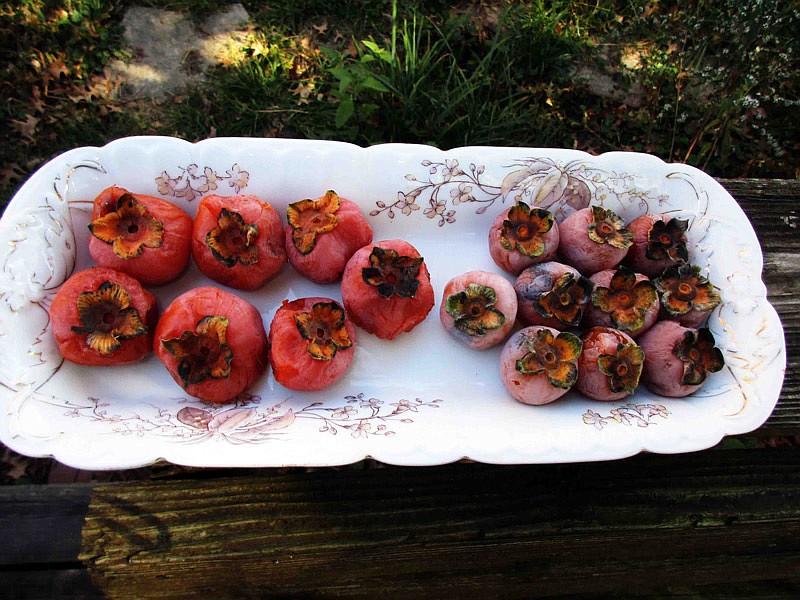Persimmon season is right around the corner. The edible fruits soon will be ready to harvest.
The pulp of persimmons can be used as the main ingredient to prepare cookies, cakes, puddings and custards, as well as wine, vinegar and even beer.
The fruits may still be green in early September, but pretty soon they will start changing to handsome orange-yellow or dull yellow. Most are about 1 inch in diameter, but sometimes you may find trees with larger fruits, as is the case of the trees that grow wild at the Lincoln University campus.
Persimmon is so flavorful that having many seeds shouldn't deter you from gathering it. It can be a fun and rewarding experience that you can enjoy with family or friends. The fresh fruits are delicious and sweet to eat fresh. The fruits or pulp can be stored frozen for later use. To prepare sweet goodies, sugar can be reduced or completely excluded due to persimmons' high content of sugar.
To process the pulp, you can use a food mill and store it in Ziploc bags or canning jars in the freezer, being sure to leave half an inch of free space at the top.
Approximately 12-15 persimmons can produce about a cup of pulp, depending on the size. Any leftover pulp that cannot be extracted with a mill because it clings to the seeds can be used in wine or vinegar preparation, as my husband did at home recently.
Some people are willing to buy the pulp instead of processing it themselves. I found a couple of farmers selling persimmon pulp at the Columbia Farmers Market for $5 a cup.
Another potential source of income could be selling the value-added products like pudding or cakes, especially around Thanksgiving. Persimmon pudding can be your new tradition during this family celebration. If you need gluten-free ideas, we have prepared gluten-free persimmon cookies by using sweet potatoes instead of flour.
Unripe persimmons can leave bad a taste in your mouth for a long time if you are unfortunate enough to be part of that joke, as happened to me. For years I didn't venture to try a persimmon. It wasn't until I had my own tree that I decided to try them again, this time fully ripe; I realized then what I was missing.
A good rule of thumb is to gather soft, juicy persimmons that have fallen from the tree to be sure they are ripe. You can place a tarp under the tree to gather the ripe ones falling from the tree and keep them clean. Check for fallen persimmon every day.
You may have trees in your own backyard without knowing it. Persimmon trees produce male and female flowers in separate trees, and if you have a male tree you are out of luck. We used to have a very productive tree in our backyard in Columbia. I raised it from seed; we planted it when it was 2 years old, and it started producing three years later. We were fortunate that the tree was a female and that our house is near a woodland where there are wild trees to help pollinating ours. We enjoyed our persimmon tree for eight very productive years; unfortunately, a big storm in 2015 broke it.
It wasn't until then that we realized we had a few immature trees that opossums or other animals had planted for us. We are now waiting for three of them to bloom to determine whether we have another female tree.
Persimmons are not only tasty but also good for wildlife in fall and winter. During times of scarce food in late winter, robins and other birds that like to eat fruit came to our yard to serve themselves on the leftover ones. We had so many fruits that I sometimes stored some to give the birds a tasty treat in the winter. Persimmons can be a source of food for butterflies and other insects in the fall when the flowers get scarce.
The American persimmon, also known as Dyospiros virginiana, has a Japanese relative, known as Asian or Japanese persimmon (Dyospiros kaki). The American persimmon is more desirable for cooking; and the Japanese persimmon, which is much larger, is not as flavorful. One advantage of American persimmon is that it can be found in every county in Missouri. It is easy to grow and adapts well to fertile and non-fertile soils, moist to dry.
Persimmon grows very slowly. If the soil is rocky and not too fertile, 20- to 30-year-old trees can reach up to 30 feet. If they grow in good soil without much competition, trees can reach up to 70 feet in height.
Persimmon can be easily reproduced from seed or cuttings. The taproot is long, which makes it difficult to transplant.
Dehydrated persimmons are a good source of carbohydrates, dietary fiber, iron, calcium, Vitamin A and protein. To dehydrate persimmons, cut them in half and dry them in a dehydrator overnight at 130-140 degrees F. If you don't have a dehydrator, dry them in your oven at the lowest setting and let them set for six hours or until they are reduce to two-thirds of their size and are still soft.
Nadia Navarrete-Tindall is an associate professor and native plant specialist for the Lincoln University Cooperative Extension. The Native Plants Program provides educational tools to students and the public on how to identify, grow and market native edible plants and those that are important to pollinators.
PERSIMMON CAKE
Serves eight to 10. Gluten-free and fat-free.
cup raisins/milk
2 cups rice flour
teaspoon baking power
2 teaspoons baking soda
teaspoon salt
teaspoon ground nutmeg
1 teaspoons ground cinnamon
cup Greek yogurt (or cup butter)
1 cups persimmon pulp
2 teaspoons vanilla extract
3 eggs
1 cups non-hybrid pecans
1 cup pure cane sugar/unbleached brown sugar
Preheat oven to 350 degrees F.
Cover raisins with lukewarm milk in a saucepan for 30 minutes or longer. Set aside.
In a medium bowl, mix yogurt, persimmon pulp, eggs and vanilla extract. Set aside.
In a large bowl, mix dry ingredients. Add persimmon mix, and gently stir. Fold in strained raisins.
Pour batter into a greased, 10-inch-diameter cake pan. Bake for 40 minutes or until a knife into the cake comes out clean.
Remove from the oven. Let cool, and flip over onto a plate.
Top with cream cheese icing. Cake without icing can be kept frozen for three months or longer.
CREAM CHEESE ICING
8 ounces cream cheese, softened
teaspoon vanilla
1 teaspoon fresh Meyer lemon juice
2 teaspoons honey
2 teaspoons powdered sugar
Mix all ingredients together and spread onto the persimmon cake. Prepare one or two hours before serving.


